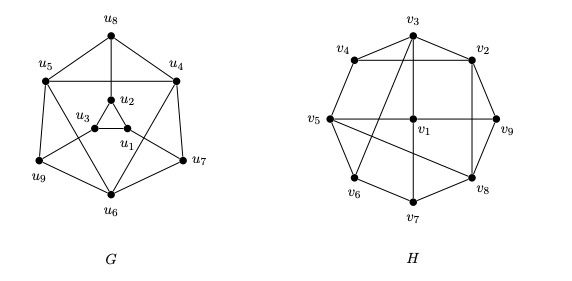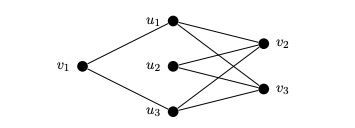
IGNOU MMTE-001 Solved Assignment 2024 | M.Sc. MACS
₹365.00
Access via our Android App Only
Please read the following points before ordering :
Share with your Friends
IGNOU MMTE-001 Assignment Question Paper 2024
mmte-001-solved-assignment-2024-bc500e58-5622-4aae-bac5-75e86f0373be
- State whether the following statements are true or false. Justify your answers with a short proof or a counterexample
i) There exists no 9-vertex graph with three vertices of degree 3 , four vertices of degree 2 and two vertices of degree 1 .
ii)C_(6)vvP_(4) C_6 \vee P_4
iii) The diameter of a graph cannot exceed its girth.
iv) Every Hamiltonian graph is Eulerian.
v) Every 3-connected graph is 3-edge-connected.
vi) IfG G L(G) L(G)
vii)chi^(‘)(C_(3)xxK_(2))=3 \chi^{\prime}\left(C_3 \times K_2\right)=3
viii) There exists no graphG G chi(G) > omega(G)+1 \chi(G)>\omega(G)+1
ix) The minimum size of ak k ([k],[2]) \left(\begin{array}{c}k \\ 2\end{array}\right)
x) The 6-dimensional hypercubeQ_(6) Q_6 - (a) The complement of the Petersen graph is 2-connected. Prove or disprove.
(b) Consider a graphG G x,y in V(G) x, y \in V(G) x harr y x \leftrightarrow y z in V(G),|d(x,z)-d(y,z)| <= 1 z \in V(G),|d(x, z)-d(y, z)| \leq 1
(c) Check whether the following graphsG G H H

- (a) Let
G G n n G G G G n n
(b) Find a minimum-weigh spanning tree in the following graph.

(d) Find the chromatic and edge-chromatic numbers of the following graph.

- (a) Find the number of spanning trees of the following graph.

(c) Give an example of a 4-critical graph different from a complete graph. Justify the choice of your example.
(d) State and prove the Handshaking Lemma for planar graphs.
- (a) Verify Euler’s formula for the following plane graph.

(c) What is the minimum possible thickness of a 4-connected triangle-free graph on 8 vertices? Also draw such a graph.
(d) Define the parameters
6. (a) What is the maximum possible flow that can pass through the following network? Define such a flow.

(c) Let
- (a) Find the values of
n n Q_(n) Q_n
(b) Using Fleury’s algorithm, find an Eulerian circuit in the following graph.

MMTE-001 Sample Solution 2024
mmte-001-solved-assignment-2024-ss-8e24e610-06c9-4b43-84f6-a5bf6ef5ab5c
- State whether the following statements are true or false. Justify your answers with a short proof or a counterexample
i) There exists no 9-vertex graph with three vertices of degree 3 , four vertices of degree 2 and two vertices of degree 1 .
- Three vertices of degree 3
- Four vertices of degree 2
- Two vertices of degree 1
C_(6) C_6 P_(4) P_4 - The operation
vv \vee
- The diameter of a graph is the length of the longest shortest path between any two vertices in the graph.
- The girth of a graph is the length of the shortest cycle in the graph.
- A Hamiltonian graph is a graph that contains a Hamiltonian cycle, which is a cycle that visits every vertex exactly once.
- An Eulerian graph is a graph in which all vertices have even degree, and there exists a cycle (called an Eulerian cycle) that traverses every edge exactly once.
- A graph is said to be
k k k-1 k-1 - A graph is said to be
k k k-1 k-1
- An Eulerian graph is a graph in which there exists a closed walk that visits every edge exactly once.
L(G) L(G) G G G G L(G) L(G) G G G G
chi^(‘)(G) \chi^{\prime}(G) G G G G C_(3) C_3 K_(2) K_2 C_(3)xxK_(2) C_3 \times K_2 C_(3) C_3 K_(2) K_2 C_(3) C_3 K_(2) K_2
chi(G) \chi(G) G G G G omega(G) \omega(G) G G G G
- A
k k chi(G) \chi(G) k k - The size of a graph refers to the number of edges in the graph.
([k],[2]) \left(\begin{array}{c}k \\ 2\end{array}\right) k k (k(k-1))/(2) \frac{k(k-1)}{2}
- A hypercube
Q_(n) Q_n n n 2^(n) 2^n n n - A perfect matching in a graph is a set of edges such that every vertex in the graph is incident to exactly one edge in the set.
Frequently Asked Questions (FAQs)
You can access the Complete Solution through our app, which can be downloaded using this link:
Simply click “Install” to download and install the app, and then follow the instructions to purchase the required assignment solution. Currently, the app is only available for Android devices. We are working on making the app available for iOS in the future, but it is not currently available for iOS devices.
Yes, It is Complete Solution, a comprehensive solution to the assignments for IGNOU. Valid from January 1, 2023 to December 31, 2023.
Yes, the Complete Solution is aligned with the IGNOU requirements and has been solved accordingly.
Yes, the Complete Solution is guaranteed to be error-free.The solutions are thoroughly researched and verified by subject matter experts to ensure their accuracy.
As of now, you have access to the Complete Solution for a period of 6 months after the date of purchase, which is sufficient to complete the assignment. However, we can extend the access period upon request. You can access the solution anytime through our app.
The app provides complete solutions for all assignment questions. If you still need help, you can contact the support team for assistance at Whatsapp +91-9958288900
No, access to the educational materials is limited to one device only, where you have first logged in. Logging in on multiple devices is not allowed and may result in the revocation of access to the educational materials.
Payments can be made through various secure online payment methods available in the app.Your payment information is protected with industry-standard security measures to ensure its confidentiality and safety. You will receive a receipt for your payment through email or within the app, depending on your preference.
The instructions for formatting your assignments are detailed in the Assignment Booklet, which includes details on paper size, margins, precision, and submission requirements. It is important to strictly follow these instructions to facilitate evaluation and avoid delays.
Terms and Conditions
- The educational materials provided in the app are the sole property of the app owner and are protected by copyright laws.
- Reproduction, distribution, or sale of the educational materials without prior written consent from the app owner is strictly prohibited and may result in legal consequences.
- Any attempt to modify, alter, or use the educational materials for commercial purposes is strictly prohibited.
- The app owner reserves the right to revoke access to the educational materials at any time without notice for any violation of these terms and conditions.
- The app owner is not responsible for any damages or losses resulting from the use of the educational materials.
- The app owner reserves the right to modify these terms and conditions at any time without notice.
- By accessing and using the app, you agree to abide by these terms and conditions.
- Access to the educational materials is limited to one device only. Logging in to the app on multiple devices is not allowed and may result in the revocation of access to the educational materials.
Our educational materials are solely available on our website and application only. Users and students can report the dealing or selling of the copied version of our educational materials by any third party at our email address (abstract4math@gmail.com) or mobile no. (+91-9958288900).
In return, such users/students can expect free our educational materials/assignments and other benefits as a bonafide gesture which will be completely dependent upon our discretion.
Related products
-
IGNOU Assignment Solution
IGNOU MEG-14 Solved Assignment 2022-2023 | MEG | Contemporary Indian Literature in English Translation
₹101.00 Go to the App -
IGNOU Assignment Solution
IGNOU MEG-09 Solved Assignment 2022-2023 | MEG | Australian Literature
₹101.00 Go to the App -
IGNOU Assignment Solution
IGNOU MEG-05 Solved Assignment 2022-2023 | MEG | LITERARY CRITICISM & THEORY
₹101.00 Go to the App -
IGNOU Assignment Solution
IGNOU MEG-04 Solved Assignment 2022-2023 | MEG | ASPECTS OF LANGUAGE
₹101.00 Go to the App




